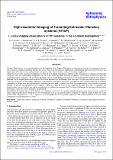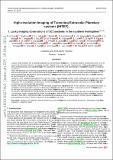Files in this item
High-resolution Imaging of Transiting Extrasolar Planetary systems (HITEP). I. Lucky imaging observations of 101 systems in the southern hemisphere
Item metadata
| dc.contributor.author | Evans, D. F. | |
| dc.contributor.author | Southworth, J. | |
| dc.contributor.author | Maxted, P. F. L. | |
| dc.contributor.author | Skottfelt, J. | |
| dc.contributor.author | Hundertmark, M. | |
| dc.contributor.author | Jørgensen, U. G. | |
| dc.contributor.author | Dominik, M. | |
| dc.contributor.author | Alsubai, K. A. | |
| dc.contributor.author | Andersen, M. I. | |
| dc.contributor.author | Bozza, V. | |
| dc.contributor.author | Bramich, D. M. | |
| dc.contributor.author | Burgdorf, M. J. | |
| dc.contributor.author | Ciceri, S. | |
| dc.contributor.author | D'Ago, G. | |
| dc.contributor.author | Figuera Jaimes, R. | |
| dc.contributor.author | Gu, S.-H. | |
| dc.contributor.author | Haugbølle, T. | |
| dc.contributor.author | Hinse, T. C. | |
| dc.contributor.author | Juncher, D. | |
| dc.contributor.author | Kains, N. | |
| dc.contributor.author | Kerins, E. | |
| dc.contributor.author | Korhonen, H. | |
| dc.contributor.author | Kuffmeier, M. | |
| dc.contributor.author | Mancini, L. | |
| dc.contributor.author | Peixinho, N. | |
| dc.contributor.author | Popovas, A. | |
| dc.contributor.author | Rabus, M. | |
| dc.contributor.author | Rahvar, S. | |
| dc.contributor.author | Schmidt, R. W. | |
| dc.contributor.author | Snodgrass, C. | |
| dc.contributor.author | Starkey, D. | |
| dc.contributor.author | Surdej, J. | |
| dc.contributor.author | Tronsgaard, R. | |
| dc.contributor.author | von Essen, C. | |
| dc.contributor.author | Wang, Yi-Bo | |
| dc.contributor.author | Wertz, O. | |
| dc.date.accessioned | 2016-04-29T09:30:10Z | |
| dc.date.available | 2016-04-29T09:30:10Z | |
| dc.date.issued | 2016-05 | |
| dc.identifier | 242241504 | |
| dc.identifier | 61662452-cc7b-44a7-bc2b-889a48f60c3a | |
| dc.identifier | 84964652723 | |
| dc.identifier | 000375318300070 | |
| dc.identifier.citation | Evans , D F , Southworth , J , Maxted , P F L , Skottfelt , J , Hundertmark , M , Jørgensen , U G , Dominik , M , Alsubai , K A , Andersen , M I , Bozza , V , Bramich , D M , Burgdorf , M J , Ciceri , S , D'Ago , G , Figuera Jaimes , R , Gu , S-H , Haugbølle , T , Hinse , T C , Juncher , D , Kains , N , Kerins , E , Korhonen , H , Kuffmeier , M , Mancini , L , Peixinho , N , Popovas , A , Rabus , M , Rahvar , S , Schmidt , R W , Snodgrass , C , Starkey , D , Surdej , J , Tronsgaard , R , von Essen , C , Wang , Y-B & Wertz , O 2016 , ' High-resolution Imaging of Transiting Extrasolar Planetary systems (HITEP). I. Lucky imaging observations of 101 systems in the southern hemisphere ' , Astronomy & Astrophysics , vol. 589 , A58 . https://doi.org/10.1051/0004-6361/201527970 | en |
| dc.identifier.issn | 0004-6361 | |
| dc.identifier.other | BibCode: 2016A&A...589A..58E | |
| dc.identifier.other | ORCID: /0000-0002-3202-0343/work/75996756 | |
| dc.identifier.uri | https://hdl.handle.net/10023/8700 | |
| dc.description.abstract | Context. Wide binaries are a potential pathway for the formation of hot Jupiters. The binary fraction among host stars is an important discriminator between competing formation theories, but has not been well characterised. Additionally, contaminating light from unresolved stars can significantly affect the accuracy of photometric and spectroscopic measurements in studies of transiting exoplanets. Aims: We observed 101 transiting exoplanet host systems in the Southern hemisphere in order to create a homogeneous catalogue of both bound companion stars and contaminating background stars, in an area of the sky where transiting exoplanetary systems have not been systematically searched for stellar companions. We investigate the binary fraction among the host stars in order to test theories for the formation of hot Jupiters. Methods: Lucky imaging observations from the Two Colour Instrument on the Danish 1.54 m telescope at La Silla were used to search for previously unresolved stars at small angular separations. The separations and relative magnitudes of all detected stars were measured. For 12 candidate companions to 10 host stars, previous astrometric measurements were used to evaluate how likely the companions are to be physically associated. Results: We provide measurements of 499 candidate companions within 20 arcsec of our sample of 101 planet host stars. 51 candidates are located within 5 arcsec of a host star, and we provide the first published measurements for 27 of these. Calibrations for the plate scale and colour performance of the Two Colour Instrument are presented. Conclusions: We find that the overall multiplicity rate of the host stars is 38+17-13 %, consistent with the rate among solar-type stars in our sensitivity range, suggesting that planet formation does not preferentially occur in long period binaries compared to a random sample of field stars. Long period stellar companions (P> 10 yr) appear to occur independently of short period companions, and so the population of close-in stellar companions is unconstrained by our study. | |
| dc.format.extent | 20 | |
| dc.format.extent | 1148832 | |
| dc.format.extent | 1035417 | |
| dc.language.iso | eng | |
| dc.relation.ispartof | Astronomy & Astrophysics | en |
| dc.subject | Planets and satellites: dynamical evolution and stability | en |
| dc.subject | Planets and satellites: formation | en |
| dc.subject | Techniques: high angular resolution | en |
| dc.subject | Binaries: visual | en |
| dc.subject | QB Astronomy | en |
| dc.subject | QC Physics | en |
| dc.subject | NDAS | en |
| dc.subject.lcc | QB | en |
| dc.subject.lcc | QC | en |
| dc.title | High-resolution Imaging of Transiting Extrasolar Planetary systems (HITEP). I. Lucky imaging observations of 101 systems in the southern hemisphere | en |
| dc.type | Journal article | en |
| dc.contributor.sponsor | The Royal Society | en |
| dc.contributor.institution | University of St Andrews. School of Physics and Astronomy | en |
| dc.identifier.doi | 10.1051/0004-6361/201527970 | |
| dc.description.status | Peer reviewed | en |
| dc.identifier.url | http://adsabs.harvard.edu/abs/2016A%26A...589A..58E | en |
| dc.identifier.grantnumber | UF100010 / UF130581 | en |
This item appears in the following Collection(s)
Items in the St Andrews Research Repository are protected by copyright, with all rights reserved, unless otherwise indicated.


